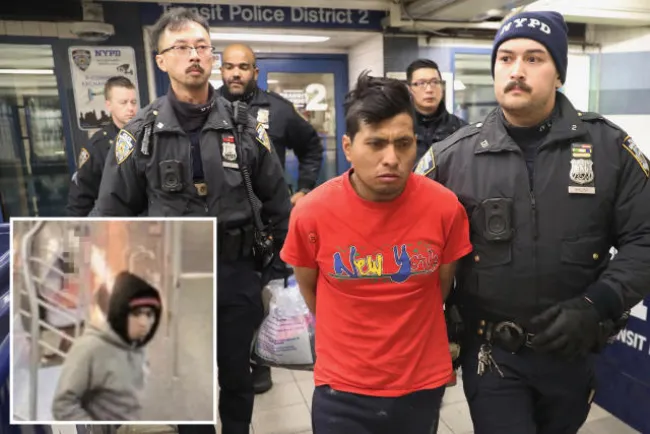Subway Inferno: The Chilling Murder of a Woman by Sebastian Zapeta-Calil and the Fallout for NYC Safety
A 33-year-old man, Sebastian Zapeta-Calil, stands accused of a horrifying act that has left New Yorkers in shock: setting a woman ablaze on a subway train and coldly watching her die in agony. Described by authorities as a "brutal murder," this heinous crime has sparked outrage and raised urgent questions about public safety and the NYPD's response.
The attack occurred on Sunday morning when Zapeta-Calil, a Guatemalan national deported in 2018 and later reentering the U.S. illegally, approached a woman on a stationary F train at the Coney Island-Stillwell Avenue station. Without a word, he set her clothes on fire. In seconds, she was engulfed in flames. Surveillance footage captured the horrific scene, showing Zapeta-Calil calmly sitting on a bench as the woman burned, her screams seemingly lost in the chaos.
Zapeta-Calil now faces charges of first- and second-degree murder and first-degree arson. However, the victim’s identity remains unconfirmed. Social media speculation has linked her to Amelia Carter, a 29-year-old woman whose alleged photo has gone viral. Some have questioned whether the image is AI-generated, and the NYPD's failure to verify her identity has only deepened public frustration and confusion.
Adding to the horror is the alleged inaction of an NYPD officer, who reportedly walked past the burning victim without offering assistance. A viral video of the incident has intensified public outrage, with many questioning how such indifference could occur. One commenter lamented, “How does this happen? An NYPD officer walks right past a woman burning alive like he’s heading to grab a gyro. This is insanity.”
This tragedy has reignited fierce debates about subway safety in New York City, where violent incidents have risen in recent years. Despite Governor Kathy Hochul's efforts to bolster security—such as deploying National Guard members and installing cameras in every subway car—the system remains perilous for vulnerable individuals. While one of these cameras recorded the gruesome act, it underscores a pressing question: Are these measures sufficient to prevent such atrocities?
Brooklyn District Attorney Eric Gonzalez has vowed to hold Zapeta-Calil accountable, calling the crime “beyond comprehension.” Yet, for many, the case highlights deeper concerns about the city’s ability to protect its residents, particularly the most vulnerable. This horrific act has not only shaken New York City but also exposed the depths of human cruelty.
The case has also fueled broader debates about immigration policy and undocumented immigrants' role in violent crimes. Zapeta-Calil, deported in 2018 and later reentering the U.S. illegally, has become a rallying point for advocates of stricter immigration enforcement. Critics argue that sanctuary city policies, which limit cooperation between local law enforcement and federal immigration authorities, allow individuals like Zapeta-Calil to reenter the country and commit heinous acts.
Meanwhile, the NYPD’s handling of the incident has come under intense scrutiny. The viral video of an officer seemingly ignoring the burning victim has led to calls for accountability and reform within the department. Some have questioned whether the officer followed protocol or if systemic issues within the NYPD contributed to the perceived inaction. Police Chief Joseph Gulotta defended the officer, claiming he was securing the crime scene, but this explanation has done little to assuage public anger.
The incident also underscores broader concerns about subway safety in New York City. Despite initiatives by Governor Hochul and Mayor Eric Adams to reduce subway crime, recent violent incidents—including stabbings and shootings—have left many commuters feeling unsafe. The F train attack is just one of several high-profile crimes this year, prompting calls for more comprehensive safety measures, including increased police presence, better coordination among law enforcement agencies, and enhanced mental health support for vulnerable individuals.
As the investigation into Zapeta-Calil’s actions continues, the case serves as a grim reminder of the challenges facing New York City’s subway system. The brutal murder of an innocent woman has laid bare critical issues surrounding safety, immigration, and law enforcement. For many New Yorkers, one question looms large: What will it take to make the subway safe for everyone?
